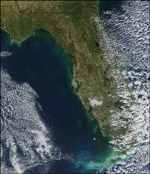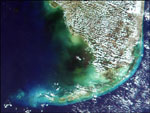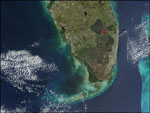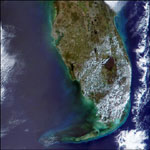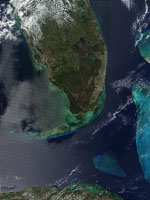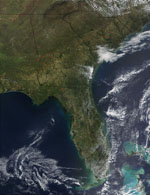|
MODIS - Terra
Moderate Resolution Imaging Spectroradiometer
NORTH AMERICA
Click on an image to see the full-sized version.
Bahamas
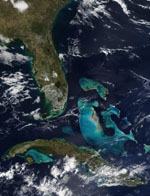 |
Surrounding the islands of Cuba and the Bahamas are colonies of marine phytoplankton whose chlorophyll and other pigments reflect an intense blue-green color. |
California
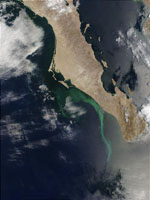 |
A green tendril of what could be a phytoplankton or sulfur bloom snakes its way south of the Baja California peninsula in this true-color image. If this is a phytoplankton bloom, then the color is due to sunlight reflecting off of chlorophyll in the phytoplankton. If this is a sulfur bloom, the color is result of hydrogen sulfide that oxidized into sulfur gas at the surface of the ocean. |
Florida
Maine
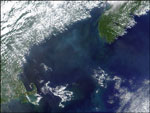 |
Trillions of calcite (limestone) coated phytoplankton, known as coccolithophores, appeared in the waters off the coast of Maine. |
Mexico
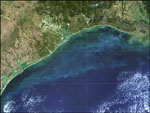 |
Red tides blooming along a 300-mile stretch of Texas' Gulf Coast, killing millions of fish and shellfish as well as making some people sick. State officials are calling this the worst red tide bloom in 14 years. This true-color image of the Texas Gulf Coast was acquired on September 29, 2000, by the Moderate-resolution Imaging Spectroradiometer (MODIS) flying aboard NASA's Terra spacecraft. The algae produces a poison that paralyzes fish and prevents them from breathing. For further information please see NASA's Earth Observatory News section.
|
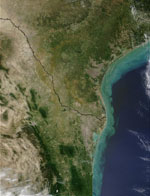 |
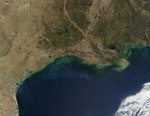 |
Brightly-colored waters in the Gulf of Mexico indicate the presence of sediment, detritus, and blooms of phytoplankton.
|
Mississippi Delta
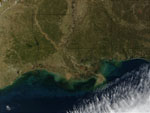 |
Sediment from the Mississippi River, running roughly down the center of the image, fills the Delta as it opens into the Gulf of Mexico. Mixed with the tan sediment are blue and green swirls that indicate a bloom of phytoplankton. Such blooms can culminate in red tides, in which toxins given off by the rapidly growing algae kill fish and other marine animals.
|
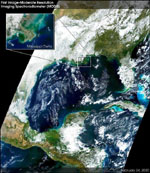 |
This image of the Mississippi Delta was acquired on February 24, 2000 and is one of the first scenes acquired by the Moderate resolution Imaging Spectroradiometer (MODIS) on the EOS-Terra Spacecraft. It covers an area of 100km by 100km over New Orleans, Louisiana and the Gulf of Mexico. Some features clearly visible on the image are:
- sediment plumes around the delta and between the barrier islands north of it
- differences in ocean color between the shallow bays behind the barrier islands and the open waters of the Gulf of Mexico.
The scene was made by combining three of the visible bands of the MODIS Land Surface Reflectance product.
|
Newfoundland
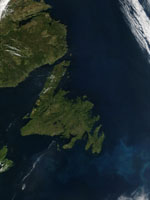 |
To the southeast of Newfoundland, a phytoplankton bloom is coloring the waters of the Atlantic Ocean bright blue and green. This true-color image shows the bloom curving around to the northwest and reaching into the Cabot Strait, which separates Newfoundland from Cape Breton Island, Nova Scotia.
|
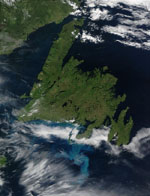 |
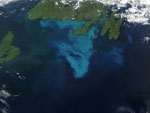 |
In the waters of the Atlantic Ocean, south of Newfoundland, Canada, a brightly colored blue swirl indicates the presence of an ongoing phytoplankton bloom. |
Back |
Ocean-Colour gallery |
Ocean-Colour Sensors |
Home
|






